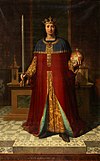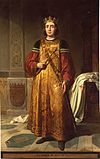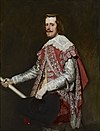List of Castilian monarchs

| Monarchs of the Iberian Peninsula |
|---|
This is a list of kings regnant and queens regnant of the Kingdom and Crown of Castile. For their predecessors, see List of Castilian counts.
Kings and Queens of Castile
[edit]Jiménez dynasty
[edit]| Monarch | Image | Epithet | Reign began | Reign ended | Notes |
|---|---|---|---|---|---|
| Sancho II | 
|
the Strong | 27 December 1065 | 6 October 1072 | Oldest son of Ferdinand I of León, who ruled León and Castile, and declared himself Emperor of Spain.
Ferdinand did not, however, pass both of his kingdoms on to Sancho but on his death gave instructions to divide the kingdoms among his sons, with Sancho receiving Castile, Alfonso receiving León, and Galicia elevated as a separate kingdom for Garcia. But it did not go well. In 1071, Garcia's kingdom of Galicia was attacked, conquered, and divided between his brothers, and in 1072, Alfonso's kingdom of León was attacked and conquered by Sancho. Sancho did not enjoy his conquests long, however, as in that same year, Sancho was assassinated. He died without children. |
| Alfonso VI | 
|
the Brave
the Valiant |
6 October 1072 | 30 June 1109 | Son of Ferdinand I, brother of his predecessor Sancho II.
Ferdinand had ruled León and Castile, and on his death attempted to divide his kingdoms between his sons, with Sancho receiving Castile, Alfonso receiving León, and Garcia receiving a newly elevated kingdom of Galicia. Alfonso had first participated with Sancho in dividing Garcia's kingdom between them in 1071, only to lose his own to Sancho in 1072. Happily for Alfonso, Sancho, who was still childless, was almost immediately assassinated, creating opportunities for his brothers to return and attempt to reclaim their father's kingdoms. As it happened, this only worked out for Alfonso, who captured and imprisoned Garcia, taking all three kingdoms under Alfonso's control. Alfonso also seems to have adopted the title Emperor of All Spain, sometimes used by his father. |
| Urraca | 
|
the Reckless | 30 June 1109 | 8 March 1126 | Daughter of Alfonso VI, and sister to Sancho Alfónsez. Urraca came to the throne on the death of her father, as her brother had died in 1108.
As Alfonso was king of León as well as Castile, he passed both kingdoms to Urraca. An attempt to create a dynastic unity with neighboring Aragon by a marriage with its king, Alfonso VI of Aragon, spectacularly failed. Not only was the marriage childless, Alfonso actively waged war on his wife until his death in 1114. Urraca did seem to sometimes use the title Empress of All Spain. |
House of Ivrea / Burgundy
[edit]
The following dynasts are descendants, in the male line, of Urraca's first husband, Raymond of Burgundy.
| Monarch | Image | Epithet | Began | Ended | Notes |
|---|---|---|---|---|---|
| Alfonso VII | 
|
The Emperor | 10 March 1126 | 21 August 1157 | Oldest son of Urraca. His other inherited titles include King of León, and King of Galicia. He also claimed the title Emperor of all Spain. |
| Sancho III | 
|
The Desired | 21 August 1157 | 31 August 1158 | Oldest son of Alfonso VII. Although his father was king of Castile, León, and Galicia, Sancho only inherited Castile, with León and Galicia going to his younger brother Ferdinand. (Castile , León, and Galicia would be later re-united in 1230 under Ferdinand III.) |
| Alfonso VIII | 
|
The Noble | 31 August 1158 | 6 October 1214 | Oldest son of Sancho III. Ascending to the throne at the age of 2, the kingdom was divided by a power struggle over control of his regency, which lasted until he was 15. |
| Henry I | 
|
6 October 1214 | 6 June 1217 | Oldest surviving son of Alfonso VIII. He became heir when his older brother died. He ascended to the throne at the age of 10 on the death of his father, under the regency of his older sister Berengaria. His reign was short, ending with his death at age 13. | |
| Berengaria | 
|
The Great | 6 June 1217 | 30 August 1217 | Daughter of Alfonso VIII. She acted as regent for her younger brother Henry I until his early death, at which time she inherited the throne. On ascension, she immediately abdicated in favor of her son, Ferdinand III. She died in 1246. |
| All kings hereafter were also kings of León | |||||
| Ferdinand III | 
|
The Saint | 30 August 1217 | 30 May 1252 | Oldest son of Berengaria, ascending when his mother abdicated in his favor. Also from 1230, through his father, he was King of León and King of Galicia as well. The three kingdoms were thereafter dynastically bound together. |
| Alfonso X | 
|
The Wise | 30 May 1252 | 4 April 1284 | Oldest son of Ferdinand III. He was elected King of Germany in 1257, a title which he held without ever gaining any authority by it until he renounced it in 1275. |
| Sancho IV | 
|
The Brave | 4 April 1284 | 25 April 1295 | Son of Alfonso X. He ascended over the claims on behalf of the minor son of his deceased older brother Fernando de la Cerda. (The traditions of Proximity of blood and Agnatic seniority, by which younger sons would be preferred over grandsons, were not dead in Castile.) To retain power, Sancho executed thousands of his nephew's supporters during his reign. |
| Ferdinand IV | 
|
The Summoned | 25 April 1295 | 7 September 1312 | Oldest son of Sancho IV. He ascended as a minor, amid disputes regarding competing claims to his throne and his regency. His mother retained custody of him (though not the regency) until he was old enough to hold power for himself in 1301. |
| Alfonso XI | 
|
The Just | 7 September 1312 | 26 March 1350 | Oldest son of Ferdinand IV. He ascended as an infant, and was under a divided regency of multiple relatives until he took power in 1325.
His passion for his mistress led to her having 10 illegitimate children by him, one of whom, the future Henry II, deposed and executed Alfonso's son and successor, Peter. |
| Peter | 
|
The Cruel | 26 March 1350 | 23 March 1369 | Oldest legitimate son of Alfonso XI. After a tumultuous reign, an uprising against him begn in 1366, led by his illegitimate half-brother, the future Henry II. Peter was deposed and executed by Henry in 1369. |
Civil War
[edit]In 1366, Peter's conduct led to an uprising by his illegitimate half-brother Henry with support from France and Aragon. After three years, Henry triumphed in 1369, and personally executed Peter.
House of Trastámara
[edit]
Henry II, the founder of the Trastámara dynasty was installed after victory in the Castilian Civil War.
| Monarch | Image | Epithet | Began | Ended | Notes |
|---|---|---|---|---|---|
| Henry II | 
|
The Bastard | 23 March 1369 | 29 May 1379 | Illegitimate son of Alfonso XI and his mistress Eleanor de Guzmán. Also half-brother to Peter. Peter's unpopularity led to Henry's successful rebellion against him in the Castilian Civil War, beginning in 1366 and ending in 1369 with Henry on the throne. |
| John I | 
|
29 May 1379 | 9 October 1390 | Eldest son of Henry II. A dynastic challenge by John of Gaunt, son-in-law of Peter I, was resolved by marriage, with John I taking John of Gaunt's daughter Catherine as his wife and queen. | |
| Henry III | 
|
The Infirm | 9 October 1390 | 25 December 1406 | Eldest son of John I. He was age 11 on ascension, but after an unstable regency, took power while still only 13. |
| John II | 
|
25 December 1406 | 21 July 1454 | Eldest son of Henry III. He was a minor on ascension, and so placed under a regency. From 1406, his mother Catherine and uncle Ferdinand I of Aragon were co-regents until his death in 1416. From then his mother alone until her death in 1418. | |
| Henry IV | 
|
The Impotent | 21 July 1454 | 11 December 1474 | Eldest son of John II. Henry was childless except for a single daughter, Joanna, who was widely regarded as illegitimate. Henry was forced in 1464 to declare his half-brother Alfonso as his heir. Alfonso's death, however, meant that his heir designate would be his half-sister, Isabella I. |
| Isabella I | 
|
The Catholic | 11 December 1474 | 26 November 1504 | Half-sister of Henry IV. Her succession was disputed by partisans of Henry's (allegedly illegitimate) daughter Joanna, resulting in the War of the Castilian Succession, which lasted until 1479, with the resolution in Isabella's favor.
Isabella's husband Ferdinand, ruled with her as co-monarch of Castile, while on his ascension to the Crown of Aragon, she ruled as co-monarch of Aragon. |
| Ferdinand V | 
|
The Catholic | 15 January 1475 | 26 November 1504 | Co-monarch through his wife Isabella. In 1479, Ferdinand succeeded his father to the Crown of Aragon, uniting the realms by marriage, laying the foundation for the modern nation of Spain.
On Isabella's death, as she was succeeded by their daughter Joanna I and her husband Philip I. Ferdinand, no longer king, then left the Castile and returned to Aragon. But after her husband Philip's death in 1506, Joanna proved unable to rule, and Ferdinand was recalled, after which he governed Castile as her regent until his death in 1416. |
| Joanna I | 
|
The mad | 26 November 1504 | 12 April 1555 | In name, with her husband Philip I (1504–1506). From 1506 to 1516, she was under two regencies: Archbishop Cisneros (1506-1508) and her father Ferdinand V (1508–1516). In 1516, her son Charles I, had himself crowned co-monarch (1516–1555). From 1508 onwards she was kept confined, with no public life, much less power, first by her father, then her son. |
House of Habsburg
[edit]
| Monarch | Image | Epithet | Began | Ended | Notes |
|---|---|---|---|---|---|
| Philip I | 
|
The Handsome | 26 November 1504 | 25 September 1506 | jure uxoris king ruling on behalf of his wife, Joanna I. As the oldest son of Mary of Burgundy, Philip also inherited the titles of Lord of the Netherlands and Duke of Burgundy on his mother's death in 1482. |
| Charles I | 
|
The Emperor | 13 March 1516 | 16 January 1556 | Son of Philip I and Joanna I. In 1516 he was made co-monarch with his mother, becoming sole monarch of Castile on her death in 1555.
Charles also inherited the titles Lord of the Netherlands and Duke of Burgundy on his father's death in 1506, King of Aragon on the death of his maternal grandfather Ferdinand II in 1516, and Archduke of Austria on the death of his paternal grandfather Maximilian I in 1519. In 1519, he was also elected to the non-hereditary position of Holy Roman Emperor. Governing such a vast and disparate set of realms proved exceedingly difficult. In Castile, his rule was challenged in 1520-1522 by the broadly-based Revolt of the Comuneros, and in neighboring Aragon in 1519-23 by the Revolt of the Brotherhoods. Both were overcome by a combination of force and compromise. After a long reign Charles abdicated in 1556, dividing his lands between his son Philip II (who inherited the lands of the Crown of Castile (including the Americas), the Crown of Aragon, his Italian territories, and the Netherlands) and his younger brother Ferdinand, who inherited the rest. Charles died in 1564. |
| Philip II | 
|
The Prudent | 16 January 1556 | 13 September 1598 | Son of Charles I. Through his father's abdication, he inherited not only the lands of the Crown of Castile (including the American colonies) but also those from the Crown of Aragon, (including the kingdoms of Naples, Sardinia, and Sicily), the Duchy of Milan, as well as the titles of Lord of the Netherlands and Duke of Burgundy.
His rule in the Netherlands was challenged by a powerful rebellion , leading to the establishment of the Dutch Republic in 1579 and the Eighty Years' War, which expanded to include multiple other wars, ending only with Spanish recognition of Dutch independence in 1648. In 1580, during a succession crisis in the Kingdom of Portugal when there was no obvious heir to the throne, Philip (a candidate in his own right) invaded and was made king that same year. Through his marriage to Mary I of England in 1554, Philip was nominal King of England until her death, but he never exercised any power there. |
| Philip III | 
|
The Pious | 13 September 1598 | 31 March 1621 | Son of Philip II. Philip III became heir to the crown after the death of his older brother, Carlos, who died insane and in captivity in 1568. |
| Philip IV | 
|
The Great | 31 March 1621 | 17 September 1665 | Oldest son of Philip III.
A revolt against Philip in Portugal led to Portugal's regaining its independence in the Portuguese Restoration War, from 1640-1668. |
| Charles II | 
|
The Bewitched | 17 September 1665 | 1 November 1700 | Oldest surviving son of Philip IV. (Two older brothers died young.) His reign was marked by his life-long ill-health and he died childless, leading to the War of the Spanish Succession, from 1701 to 1714. |
House of Bourbon
[edit]
| Monarch | Image | Epithet | Began | Ended | Notes |
|---|---|---|---|---|---|
| Philip V | 
|
1 November 1700 | 1715 (Nueva Planta decrees dissolved the Crown of Castile) | Named as successor by Charles II. His ascension triggered the War of the Spanish Succession, which was resolved by his giving up his territories in the Low Countries and Italy. In 1715, the Nueva Planta decrees dissolved the Crown of Castile. |
The Crown of Castile existed in its own right within the Spanish crown and with its own law until the arrival of the Bourbon dynasty after the War of Spanish Succession.
See also
[edit]- List of Castilian consorts
- Kingdom of Castile
- List of Aragonese monarchs
- List of Leonese monarchs
- List of Navarrese monarchs
- List of Spanish monarchs
Further reading
[edit]- Barton, Simon. The Aristocracy in Twelfth-Century León and Castile. Cambridge University Press, 1997. Appendix I: "The Counts of Twelfth Century León and Castile and Aragon, pp. 235–302.

